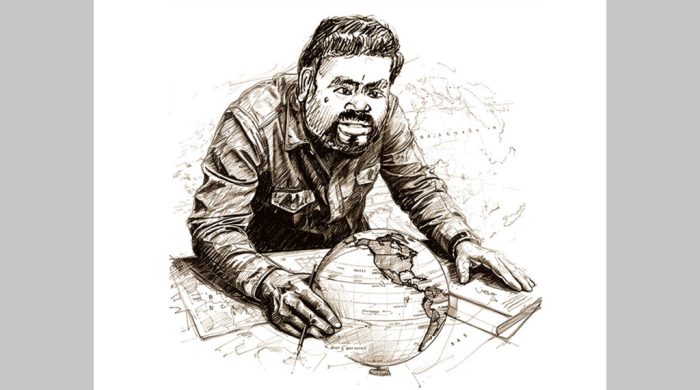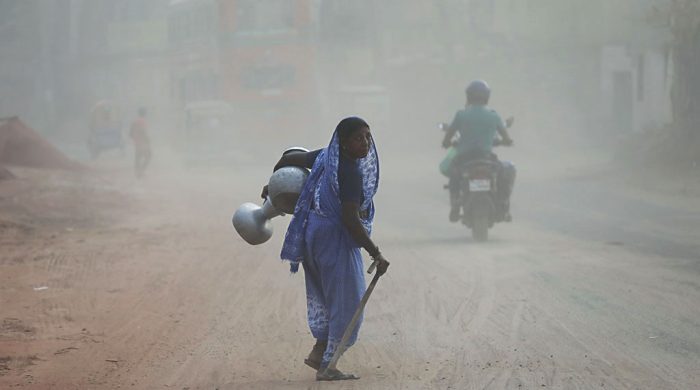World drought gets worse, cities ration

- Update Time : Thursday, May 12, 2022
- 99 Time View

THE planet is wheezing, coughing and sputtering because of vicious attacks by worldwide droughts aided and abetted by global warming at only 1.2C above baseline. Some major metropolises are rationing water.
What’ll happen at 1.5C?
It’s not as if droughts are not a normal feature of the climate system. They are, but the problem nowadays is highlighted by reports from NASA and NOAA stating that earth is trapping nearly twice as much heat is it did in 2005 described as an ‘unprecedented increase amid the climate crisis.’ This trend is described as ‘quite alarming.’
The planet trapping heat at double the rate of only 17 years ago is off-the-charts bad news and reason enough for the world’s leaders to go all in on global warming preventive measures, and then hope and pray that it’s not too late.
Throughout earth’s history drought has been a normal feature of climate change, but that’s the past. Droughts are no longer normal features. They are much, much more severe and longer lasting, for example, drought in the west region of the United States is ongoing for 20 years, the worst in 1,200 years, and it’s taken Lake Mead water levels down to 1937 levels when it first started filling up.
On a worldwide basis, drought’s impact on water reservoirs on every continent is chilling. Agricultural yields are suffering.
Undoubtedly, the utter failure by the world’s political leaders to respect 30–50 years of public warnings by scientists to ‘get off fossil fuels as soon as possible’ is coming home to roost. When will the general public fight back and throw out climate-change denier politicians along with their motley shrilly charlatans?
Along those lines, in an historic judgment, a Belgian court ruled that Belgium’s climate failures violate human rights, stating that public authorities broke promises to tackle the climate issue. About 58,000 citizens served as co-plaintiffs in the case. To wit: ‘By not taking all “necessary measures” to prevent the “detrimental” effects of climate change, the court said, Belgian authorities had breached the right to life (Article 2) and the right to respect for private and family life (Article 8).’
A major study of soil moisture drought in Europe during the period from 1766 to 2020 led to the conclusion that recent drought events brought the ‘most intense drought conditions for Europe in 250 years: ‘We conclude that Europe should prepare adaptation and mitigation plans for future events whose intensity may be comparable to the previous event, but whose duration, and partly their spatial extent, will be much greater than any event observed in the last 250 years.’
An international team led by the University of Cambridge found that after a long-term drying trend, European drought conditions since 2015 have suddenly intensified beyond anything in the past 2,000 years.
Eastern Europe is feeling the impact of serious drought. A report from the Atlantic Council in 2021 ‘emphasised the impacts of drought on Ukraine’s grain exports, noting that they had “fallen sharply year-on-year during the current season due to smaller harvests caused by severe drought conditions.” When an agricultural power as important as Ukraine suddenly starts producing and exporting much less food, it is a recipe for social dislocation, human suffering, and political unrest, both inside the country and beyond.’
According to the European Commission, ‘A severe drought has been affecting northern Italy and the Po River basin in particular.’ In Northern Italy, ‘Most of the reservoirs are below the minimum historical values… stored energy as of March 2022 is 27.5 per cent less than the eight-year minimum.’ Both agricultural yield and costs for power are negatively impacted. That -27.5 per cent is 27.5 per cent below the 8-yr minimum.
In the United States, according to the Palmer Drought index, severe to extreme drought is affecting 38 per cent of the contiguous US as of March 2022. That’s almost as bad as it ever gets. More than 50 per cent of the country registers as moderate-to-extreme. As a result, the US Bureau of Reclamation is scrambling to retain/add/cheat/steal enough water for the US’s two largest reservoirs, Lake Powell and Lake Mead, to keep hydropower supplying electrical power to 5M and water to 40M. Rationing to some of seven SW states has already started. Is that the eye-opener of all eye-openers? Answer: yes.
Historic drought has literally changed the landscape in parts of South America: ‘Until 2020, there was plenty of water, swamps, stagnant lakes and lagoons in Argentina’s Ibera Wetlands, one of the largest such ecosystems in the world. But an historic drought of the Parana River dried much of it out; its waters are in the lowest level since 1944. Since January it has been the stage of raging fires.’
Chile is experiencing such a horrendous record-breaking drought that the capital city Santiago, population six million, is rationing water. The city will experience rotating water cut-offs of up to 24 hours at a time in a four-tier alert system with public service announcements so residents can prepare for no water. ‘This is the first time in history that Santiago has a water rationing plan due to the severity of climate change, It’s important for citizens to understand that climate change is here to stay. It’s not just global, it’s local,’ according to Claudio Orrego, governor of the Santiago metropolitan region.
In Southeast Asia, the Mekong River serves as the waterway for the livelihood of 65 million people. This is the fourth year of drought. According to the ministry of water resources, river conditions are the worst in 60 years. For example, in Cambodia water capacity for crop irrigation is at only 20 per cent. Upstream dams in China and Laos also negatively add to the impact of severe drought conditions.
In China, the port city of Guangzhou and Shenzhen, which links Hong Kong to mainland China, have put residents on notice to cut/reduce water consumption between January and October of 2022, as the main water source, the East River, down 50 per cent, experiences the most severe drought in decades.
In Africa, a brutal drought in Ethiopia and Kenya has caused the death of three million livestock and 30 per cent of household herds have died in Somalia. According to the United Nations, the worsening drought in the Horn of Africa puts 20 million people at risk. Rampant migration follows in the footsteps of severe drought, eg, Central America’s Dry Corridor.
As nations and states fail to adequately address the global warming issue with a Plan A, which is attacking the source, or cutting fossil fuel emissions, it becomes increasingly urgent to go to Plan B, which is adapting to the unforgiving climate system exhaust of a failed Plan A.
In 2021, the Netherlands hosted the first ever Climate Adaptation Summit, highlighting adaptation measures as crucial for minimising extreme weather events and improving water security.
The facts surrounding the current status of CO2 emissions — at all-time highs over the past millennium — and plans for expansion by the fossil fuel industry over the course of this decade, ie, China and India building new coal plants like crazy and oil companies planning to spend billions for new oil and gas expansion, dictate that adaptation to an unpredictably challenging destructive climate system is an absolute necessity because global warming isn’t going to get fixed.
It is noteworthy that Columbia University’s Dr James Hansen’s most recent monthly temperature update states:
‘Note monthly temperature anomalies on land now commonly exceed +2°C, with the Arctic anomaly often exceeding +5°C.’
The Intergovernmental Panel on Climate Change forewarned that +2°C is the upper limit where the climate system starts to get real crazy. However, at today’s overall planet temperate of +1.2°C above baseline, trouble is already evident, eg, the worst droughts in centuries found on every continent with some major cities either rationing water or suggesting voluntary cutbacks. And, predictably, food prices are just starting to skyrocket.
Frankly, human ingenuity must take over on local and regional bases to work towards ‘adaptation to a rambunctiously changing climate,’ and, of course, lots of luck. Interestingly, some of the US’s biggest western cities have learned to adapt to severe drought, as discussed in some detail in the article ‘Adapting to Drought’ published on May 3, 2022.
CounterPunch.org May 9. Robert Hunziker is a freelance writer and environmental journalist.



















